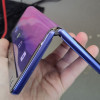Review: Huawei SnapTo
Screen
Huawei bestowed the SnapTo with a 5-inch 720p screen. It's not the best size/resolution combo in the world, but it's hardly the worst. I found the screen was sharp enough that I couldn't pick out pixels. Colors looked a bit cool to my eyes, and there was a noticeable blue shift when the screen was viewed from an angle. Brightness could be better. I was able to read the screen outdoors, but only in the shade with the brightness cranked all the way up. I've seen much better screens in this price range (hello, Moto E and Moto G), but it suffices.
Signal
Huawei sells the SnapTo unlocked; it's compatible with the networks operated by AT&T, T-Mobile, and their prepaid businesses, Cricket and MetroPCS. We tested the phone on AT&T's network and it performed about on par with AT&T-branded devices despite its lack of full optimization for AT&T's network. That means it connected to LTE 4G and stayed there most of the time. I saw it drop down to HSPA only in a few places with known coverage issues. Data speeds were OK, but not the swiftest I've seen across AT&T's network. I didn't miss any calls when testing the SnapTo, but the phone managed to bungle at least one hand-off when transiting from cell to cell. This is all to say: it works well enough.
Sound
Call quality left a bit to be desired. Calls were not quite loud enough for me, and clarity could certainly have been better. The earpiece produces just enough sound for use around your house and maybe your office, but take it outside to noisy spaces and callers' voices all but vanish into the aether. Since I needed to keep the volume up all the way, I found the speaker was prone to distortion pretty much 100% of the time. Those I spoke with through the SnapTo said I sounded pretty crummy. The speakerphone offers some relief. Volume and clarity are markedly improved when compared to the earpiece. Ringers and alerts got my attention about 50% of the time. The vibrate alert was strong enough to feel as long as the SnapTo was on my person.
Battery
The SnapTo has a 2,200 mAh power source and I found it to be adequate. Most days I used the phone it would provide uptime from breakfast to bedtime, but sometimes it didn't. It often reached critical levels around 9 or 10PM, which may not be quite enough for some users.
The phone includes some power management tools to help extend battery life. It has three basic settings: Normal (everything at full power); Smart (slower CPU clock speeds, dimmer screen); and Endurance (severely curtained CPU, aggressive network management). The phone can alert you if it senses an app sucking down battery power, but you can't set the battery saver tools to come on automatically — you have to turn them on yourself. I find that to be rather dumb.






 Hands On with the Huawei SnapTo
Hands On with the Huawei SnapTo
 Huawei Intros Unlocked SnapTo for US Buyers
Huawei Intros Unlocked SnapTo for US Buyers
 TCL's New Foldable Concept Swings Both Ways
TCL's New Foldable Concept Swings Both Ways
 iPhone 14 Plus Offers a Big Screen For Less
iPhone 14 Plus Offers a Big Screen For Less
 Motorola's new Edge+ has Dual 50 Megapixel Rear Cameras and 60 on the Front
Motorola's new Edge+ has Dual 50 Megapixel Rear Cameras and 60 on the Front
 Huawei SnapTo
Huawei SnapTo



